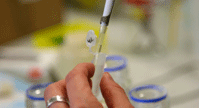Performance Predictor For Speed & Distance (MSTN)
Description:
 The modern Thoroughbred horse was developed in England during the 17th- and 18th-century when native mares were crossbred with imported Oriental stallions of Arabian, Barb, and Turkoman breeding. All modern Thoroughbreds can trace their pedigrees to three stallions originally imported into England in the 17th century and 18th century, and to a larger number of foundation mares of mostly English breeding.
The modern Thoroughbred horse was developed in England during the 17th- and 18th-century when native mares were crossbred with imported Oriental stallions of Arabian, Barb, and Turkoman breeding. All modern Thoroughbreds can trace their pedigrees to three stallions originally imported into England in the 17th century and 18th century, and to a larger number of foundation mares of mostly English breeding.
Studies have shown that sprinting capabilities of Thoroughbred horses are inherited from just a couple of ancestors. Researchers studied the pedigree of these racehorses and found that several genetic variances associated with speed may have originated in the mid-17th century from a single mare. Thanks to a single stallion named Nearctic, the father of the most-bred stallion of modern times. The gene variant became widespread in modern thoroughbreds.
Canine (Whippets):
A 2007 study in several mammal species have demonstrated that myostatin (MSTN) normally functions to limit skeletal muscle mass. In a study, Mosher et al. reported that a mutation in the canine MSTN gene is responsible for the double-muscling phenotype seen in 'bully' whippets. The study also showed that loss of even one functional MSTN allele seems to confer a competitive advantage to racing whippets, providing the first definitive evidence that loss of myostatin function can enhance athletic performance.
Thoroughbred Horses:
In the horse, it is well established that MSTN is a major quantitative trait locus that is the single most influential gene on distance aptitude. The myostatin gene regulates skeletal muscle growth. Several SNP variants have been identified to have a high correlation with performance and predictive value as to speed and distance. Horses with two copies of the C allele are more able to become fast, short-distance sprinters. Horses with one C and one T tend to be strong middle-distance runners. Horses that are T/T generally have less speed, but greater stamina and endurance.
Evidence has shown that a 227 bp SINE insertion is a very stronger predictor of speed/distance. Research clearly shows that the 227 bp SINE insertion is the relevant functional mutation and not the SNP. It is important to note that the SNP and the SINE insertion are in alignment for more than 99% of Thoroughbred horses tested. The highly significant association between the MSTN mutations and best race distance/speed confirms the usefulness of both the SNP and the SINE insertion as predictive markers of optimal race distance in the Thoroughbreds.
Relevant Breeds:
Thoroughbred and other horse breeds
Test Results SNP:
Animal Genetics offers DNA testing for a SNP mutation in the myostatin gene in Thoroughbred horses. The genetic test verifies the presence of the SNP mutation and presents results as one of the following:
| C/C | Fast, short-distance sprinters | |
| C/T | Strong middle-distance runners | |
| T/T | Greater stamina |
Test Results 227bp SINE:
Animal Genetics offers DNA testing for a functional 227bp SINE insert mutation in the myostatin gene in horses. The genetic test verifies the presence of the 227bp mutation and presents results as one of the following:
| Ins/Ins | Fast, short-distance sprinters | |
| N/Ins | Strong middle-distance runners | |
| N/N | Greater stamina |
References
PLoS One. 2018; 13(10): e0205664. Published online 2018 Oct 31. doi: 10.1371/journal.pone.0205664 PMCID: PMC6209199 PMID: 30379863
Mary F. Rooney, Conceptualization, Data curation, Formal analysis, Investigation, Methodology, Validation, Visualization, Writing – original draft, Writing – review & editing,1,2,* Emmeline W. Hill, Conceptualization, Funding acquisition, Project administration, Supervision, Writing – review & editing,2 Vincent P. Kelly, Conceptualization, Methodology, Writing – review & editing,1 and Richard K. Porter, Conceptualization, Funding acquisition, Project administration, Supervision, Writing – review & editing1
Submit a Sample for Testing:
To submit a sample for testing please click on ORDER and download a sample submission form. Then follow the sample collection and submission instructions.
Cost per sample is $95.00. Please see our fee schedules below for combination rates.










